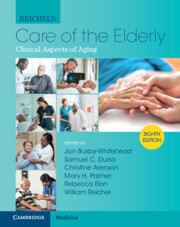Book contents
- Reichel’s Care of the Elderly
- Reichel’s Care of the Elderly
- Copyright page
- In Memoriam
- Contents
- Contributors
- Section I General Approach to the Care of the Elderly
- Chapter 1 Essential Principles in the Care of the Elderly
- Chapter 2 Biology of Aging
- Chapter 3 Comprehensive Geriatric Assessment
- Chapter 4 Screening and Prevention
- Chapter 5 Appropriate Use of Medications
- Chapter 6 Nutrition and Aging
- Chapter 7 Physical Activity and Exercise for Older Adults
- Section II Geriatric Syndromes
- Section III Care of the Elderly by Organ System
- Section IV Principles of Care for the Elderly
- Index
- Plate Section (PDF Only)
- References
Chapter 1 - Essential Principles in the Care of the Elderly
from Section I - General Approach to the Care of the Elderly
Published online by Cambridge University Press: 30 June 2022
- Reichel’s Care of the Elderly
- Reichel’s Care of the Elderly
- Copyright page
- In Memoriam
- Contents
- Contributors
- Section I General Approach to the Care of the Elderly
- Chapter 1 Essential Principles in the Care of the Elderly
- Chapter 2 Biology of Aging
- Chapter 3 Comprehensive Geriatric Assessment
- Chapter 4 Screening and Prevention
- Chapter 5 Appropriate Use of Medications
- Chapter 6 Nutrition and Aging
- Chapter 7 Physical Activity and Exercise for Older Adults
- Section II Geriatric Syndromes
- Section III Care of the Elderly by Organ System
- Section IV Principles of Care for the Elderly
- Index
- Plate Section (PDF Only)
- References
Summary
The core principle that should guide any health professional caring for older adults and their families is that the “secret of caring for the patient is in caring for the patient” (Peabody). Practitioners must understand the most up-to-date biomedical and psychosocial aspects of aging, health, wellness, and disease, and strive to support the older adult to remain as active, functional, and engaged as possible. At the same time, practitioners must recognize and help patients and families understand when a palliative approach will be most effective at meeting their goals. The Choosing Wisely campaign launched by the American Board of Internal Medicine provides targeted guidance to clinicians to provide care that is effective and efficient, consistent with the essential principles. Also, the 4Ms (what Matters, Medication, Mentation, and Mobility) proposed by The John A. Hartford Foundation and Institute for Healthcare Improvement provide a framework for an Age-Friendly Health System through which practitioners can deliver optimal care for older adults.
- Type
- Chapter
- Information
- Reichel's Care of the ElderlyClinical Aspects of Aging, pp. 1 - 11Publisher: Cambridge University PressPrint publication year: 2022



